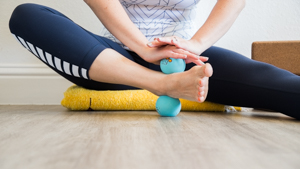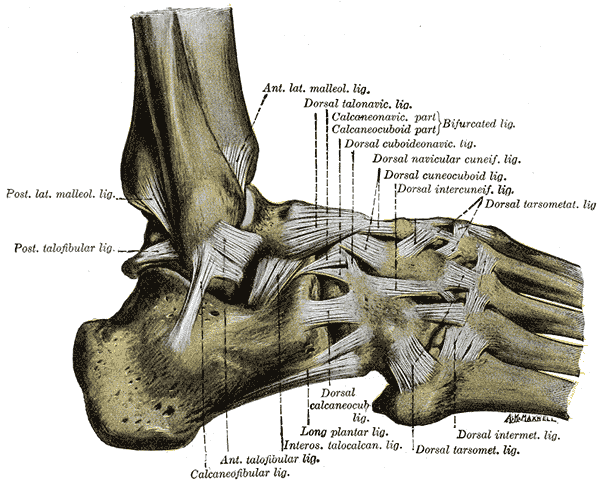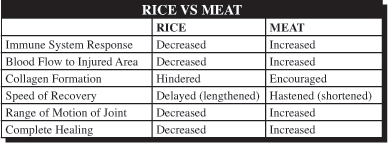
To ice, or not to ice? This is a question that is being discussed regularly among many athletic trainers, physical therapists, and other specialists, including Yoga Tune Up® Instructors. When I first heard about this debate my initial (totally uninformed) thought was “Why not ice?” Icing to reduce swelling and pain is a good thing, right? From my studies, I learned this is not necessarily true. Let’s take a look at an ankle sprain, a common injury for yogis and non-yogis alike, as an example of the effectiveness of icing after an injury.

Typically when you sprain your ankle, you misstep in a way so that you suddenly invert your foot. This causes the ligaments on the lateral side of your ankle to be overstretched or partially torn, depending on the severity. The ligaments most commonly affected are anterior talofibular ligament, calcaneofibular ligament, and the posterior talofibular ligament (shown in the image). Symptoms can include pain, swelling due to excess fluids in the tissues, and redness. So now what do you do? Do you R.I.C.E? Or M.E.A.T?
R.I.C.E (rest, ice, compress, and elevate), was coined in 1978 and has since then been considered the best practice in treating soft tissue or ligament sprains (Mirkin, 2014). M.E.A.T. (move, exercise, analgesics, and treatment) was coined as an alternative treatment option for injuries.
While there is no sufficient research comparing the two treatments, it is clear that each result in extremely different physiological responses. As you can see in the table to the right, R.I.C.E reduces the speed of recovery due to decreased blood flow, immune response, range of motion and overall healing while M.E.A.T, increases those same responses leading to a shortened recovery time.
Despite these findings, don’t be quick to chuck the R.I.C.E regime for injuries out the window. It has been suggested that when dealing with a muscle injury, R.I.C.E may be beneficial in preventing compartment syndrome, an increase in pressure in the fascial sheath of muscle caused by excess swelling (Hauser, 2014). This can decrease oxygen and increases the pH balance, which may cause permanent tissue damage in the long run (Hauser, 2014).
Due to the limited circulation already present in ligaments, it is suggested that the M.E.A.T. injury treatment method is a more appropriate approach when treating ligamentous injuries. Dr. Ross Hauser from Care Medical Rehabilitation Services Inc. found that “for each 10 degree Celsius change in the temperature, there is a more than two-fold increase in the cell metabolism. In other words, in order to increase cell metabolic rate by more than 100 percent, the temperature of the tissue must increase by 10 degrees.” Therefore a regimen like M.E.A.T., which increases blood flow, collagen formation, and complete healing, seems to be the way to go with ligament injuries.
So which do you pick? R.I.C.E? M.E.A.T? Both? No matter what direction you decide to go, Yoga Tune Up® is here to facilitate the healing process. Tune in on Friday for my favorite YTU techniques to improve ankle range of motion!
Resources
1. “Why Ice Delays Recovery.” Dr. Gabe Mirkin on Health Fitness and Nutrition. N.p., n.d. Web. 20 July 2014. <http://drmirkin.com/fitness/why-ice-delays-recovery.html>.
2. “Sports Injuries- RICE: Why We Do Not Recommend It.” Dr. Ross Hauser on Caring Medical and Rehabilitation Services (2010). <http://www.caringmedical.com/symptoms/meatvsrice.asp>
Relieve ankle pain with Yoga Tune Up.













Movement is medicine and it’s refreshingly inspired to hear new voices. The acronym M.E.AT. is new to me, thank you for sharing thisinformation so clearly and concisely.
Very interesting science. As an ex basketball player I’ve had my fair share of ankle twists, sprains, and ligament tears. I am a fan of ice, I’ve always felt the reduce in swelling has made me feel better – but what I never actually noticed is I never rested. I would stick my injury in a sloshy, freezing ice bucket, elevate it after while it thawed out, but then was on the move again with either strengthening exercises or just my normal practices (if I could put pressure on it). I think combining these 2 is a winning combination for myself! But it’s great to have more information out there to share with my clients.
Good information to have available. I am not a fan of ice as it just makes me feel worse as I don’t like any level of intense cold. I tried heat years ago with success and we have also found it to be quite effective with our clients. Encouraging gentle range of motion has made a lot of difference in recovery time. The Tune Up Balls are highly effective for self-care as the client is fully in charge and is better able to recognize the fatigue factor of overworking. Clients have been pleased with their level of improvement over other forms of physical therapy. The most important thing is finding something that the client will do to help with their own recovery. Thanks for the comparison in methodology.
Thank you for your blog.. I was not familiar with the formal MEAT concept until your blog. I found the RICE VS MEAT table very clear and information will assist me in the future.
I’ve been doing sports for more than 15 years, and all coaches that I know use and promote the R.I.C.E. method. I have adopted the “motion is lotion” idea from YTU, and I feel like I’m swimming against the stream in my sport. Now I can back my position on recovery with these scientific findings. Thank you!
Good comparison. I knew R.I.C.E. wasn’t for all injuries but didn’t know as much about M.E.A.T. You’ve set me on a course of more exploration for differences.
Very interesting post! About four weeks ago, coming down a flight of stairs too quickly, I caught my foot and inverted and everted several times before finally coming to an ungraceful end on the floor, resulting in a sprain in my ATFL and CFL. At that time there really was no way I could be doing M.E.A.T. with the acute nature of my grade II sprain (my lateral malleolus was probably larger than a lemon and weight bearing was challenging). I found doing R.I.C.E for the first week, combined with some light skin rolling with YTU original balls, was quite helpful. Being an active person, I found it extremely difficult to take it easy for long and I began M.E.A.T. a bit too quickly. The stabilizing muscles and ligaments on medial side of the ankle were forced to work overtime to compensate for the ATFL and CFL, which in my case resulted in undue strain, as they were not ready to absorb the increase in stabilization responsibilities given the injury to lateral ligaments. This set back my recovery and now the second time around I’m focusing much more on exercises to increase proprioception, range of motion, and mobilitiy. I combine this with alternating heat soak (or heating pad if limited on time) and an ice pack (for 15 minutes) to promote increased blood circulation, along with tens machine (which is a great alternative for pain management). When considering what treatment plan is right for you, consider that there may not be one right answer and as we say in Yoga Tune Up® it depends. For my recovery it was important to consider a number of factors including grade of sprain, past injuries (including if one suffers from chronic sprains), if a single or multiple ligaments are involved, existing mobility and range of motion, etc. and work with a specialist to design an appropriate rehabilitation program.
I really liked the comparison of R.I.C.E. to M.E.A.T. to support your argument- and it makes COMPLETE sense!! Thanks for shedding light on a topic that I did not know much about. I’ve been told “heat and Ice” … and it DID NOT make my sprain heal any faster or regain it’s mobility. Thanks for sharing.
I’m a RICE person – never heard about MEAT until I read your article.
Like the comparison of the 2 and it is good to now know the difference.
Very interesting info. Like most of the readers, I was not aware that MEAT was an actual method. Makes total sense. Inflammation is the body’s own natural way of healing itself. I think balance between the two methods makes the most sense.
Ok, so from my understanding, it’s generally better to use M.E.A.T. rather than R.I.C.E. due to increasing blood flow, cell metabolism and overall benefits. So why do some physiotherapists alternate between Ice and Heat then?
I appreciate this discussion on RICE vs MEAT and the resource links. In the past I’ve used RICE for many of my injuries – including a bad anterior talofibular ligament sprain that took quite a while to heal. (Perhaps it was the buckets of ice water that I soaked it in.) Thanks for pointing out that ligament injuries most likely respond better to the MEAT approach. For many years, I’ve taken the approach of short periods of ice (max of 10 minutes) to help reduce pain & swelling. Recently I’ve been experimenting with compression without the ice, which I see from your resource links that Mirkin is still recommending. Something else I’ve experimented with in recent years is alternating cold & hot water in the shower (using a hand-held shower to concentrate the spray on an injured or sore area) to help stimulate circulation and to and flushing of an injured area. A typical guideline is 2-3 rounds of 3 minutes hot water and 30-60 seconds cold water, always ending on cold.
I’ve always used the RICE technique after an injury. But I am very well familiar that in order to recover from an injury you have to strengthen that area and supporting muscles for fuller rehabilitation. To stayi stagnic would only keep that area weak and make you prone to rein jury. My only concern are for those who don’t consume analgesics maybe a natural or holistic approach like ginger or turmeric to help reduce inflammation would work. Either way I was not familiar that MEAT was an actual method. Great info.
I have never heard of MEAT before and I love it! I am constantly confused whether to RICE or not (thankfully this question doesn’t come to me very often). You have given me some great information and a base to keep doing some more homework on this subject. Either way I have learned something very new and valuable. I love MEAT!
This is really interesting, but i would want to hear more from a peer reviewed medical journal on this. I understand it may be an unreconcilable difference forever, but since these post injury treatments are so different i would want to learn more. super super interesting though.
R.I.C.E. was such a long-held go-to treatment for injuries that it seems like it will be awhile before the movement world as a whole starts to embrace the wisdom of M.E.A.T. But the science behind M.E.A.T. makes so much sense, and luckily, many people in the movement community (like you!) are espousing its powerful and efficient healing effects.
Very interesting read! I understand that the blood flow is decreased while the ice is applied. However, I feel like right after the ice is removed circulation must be vasodilatation after the ice is removed. ( http://www.gomoji.com/blog/technical-benefits-icing/ ). Either way, most of the time I have been able to relieve my aches with ice!
Katy,
This has been a recent discussion in my household as my husband is dealing with an injury, and his doctor told him to ice. After what I’ve read recently, here, and on other sites, I have my doubts that he should. Referencing the table listed, it doesn’t seem that icing is beneficial for any reason, although I know you do state that it might be a good idea for muscle injuries. I’m curious, what is the source of the table?
Informative post!! When I was injured with sciatica, could barely extend the hips without excruciating pain, I practiced the R.I.C.E. method. I feel it definitely helped but eventually needed two long and intense massages to get the circulation going before he was able to adjust my sacrum and relieve the sciatica. For this injury, that time, it took a little bit of both.
Thanks for the Hauser research finding increased metabolic rate. Logical, but good to know the research confirms. As a massage therapist, past physical therapy aide, and someone that has lived in a body for 55 years, I’m a big fan of the both/and philosophy. It’s complex… Ice brings circulation towards the area briefly as your body tries to warm the area then after the sensations cycle through cold-heat-pain-numb, the body shunts circulation away as it conserves energy by basically abandoning the area. Heat simply warms and brings circulation toward the affected area. So 20 minute ice for acute injuries with swelling and to correct for too much body heat. Gentle heat for assisting healing of areas of low circulation (not swollen or hot).
Great post!! I think the doctor who originally coined the term “RICE”, Gabe Mirkin, has recently stated that he no longer believes it to be the best treatment in all cases. It was about 35 years ago, after all, and we know that knowledge and opinions change with time. As you suggest, cases must be evaluated individually to determine the best course of action.
Interesting findings. As someone who has rolled their ankles several times throughout my athletic career, and been trained as an EMT, where I was taught the R.I.C.E. method for treating virtually all soft tissue injuries at the outset, having this research counter these initial teachings has made me rethink how to treat my own injuries moving forward. Thank you!